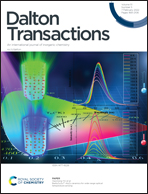Thin films composed of Zr-doped In2O3 grains rich in fracture surfaces and cracks for photoelectrochemical water oxidation†
Abstract
Zr-doped In2O3 thin films are prepared on FTO substrates by a two-step method: firstly, Zr-doped In(OH)3 thin films are hydrothermally deposited, and then converted to Zr-doped In2O3 films by heat treatment. It is found that during the phase transition from Zr-doped In(OH)3 to Zr-doped In2O3, the cuboid-like crystal grains will fragment, resulting in a large number of new surfaces and cracks. Zr doping can introduce shallow impurity levels in the band gap of In2O3, which will enhance the absorption of incident light. The substitution of trivalent In3+ ions by tetravalent Zr4+ ions provides additional donors for In2O3, which reduces the charge transfer resistance of the photoelectrochemical water oxidation and thus improves the charge transfer kinetics. These factors synergistically improve the photoelectrochemical water oxidation performance of Zr-doped In2O3. For example, at a potential of 1.5 V versus reversible hydrogen electrode, the photocurrent density of the Zr-doped In2O3 electrode during photoelectrochemical water splitting can be as high as about 3.5 times that of the undoped In2O3. Furthermore, Zr doping will also cause changes in the nucleation of some In(OH)3 grains, resulting in the formation of a small number of rod-bundle-shaped grains.



 Please wait while we load your content...
Please wait while we load your content...